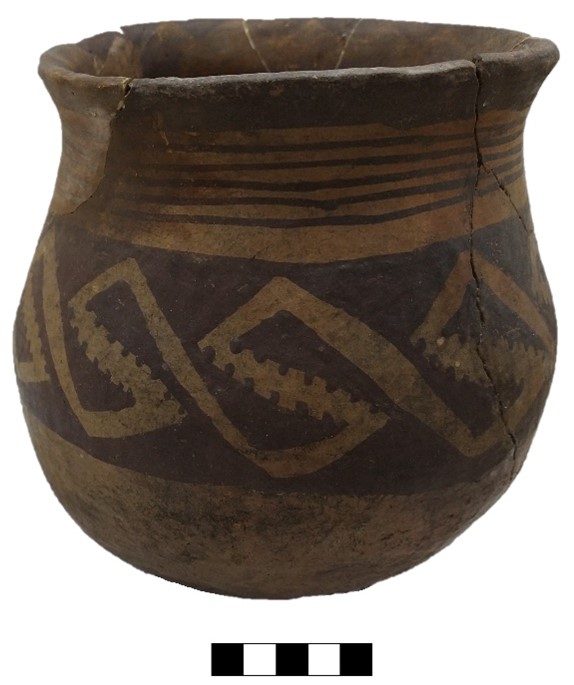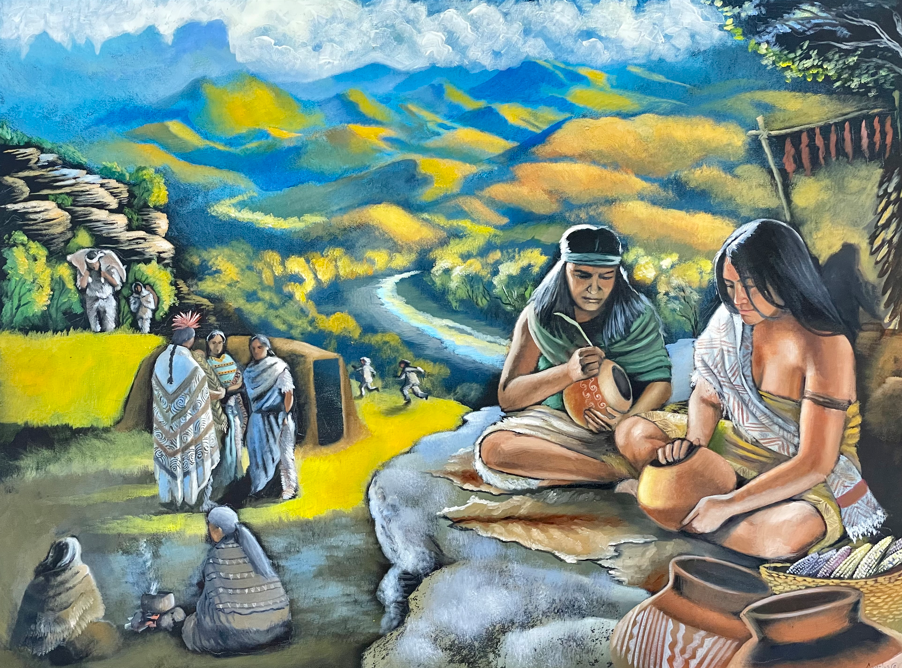Hunter M. Claypatch, PhD

Key Concepts
- Human occupation in Santa Cruz County dates back several thousand years.
- Domesticated crops, like corn and beans, were first cultivated in Mexico and entered Santa Cruz County, Arizona around 4,000 years ago.
- The Indigenous inhabitants of Santa Cruz County traded over long distances and used the fertile region around the Río Santa Cruz for the movement of people, goods, and ideas.
- Santa Cruz County’s original inhabitants were the ancestors of contemporary O’odham populations.
Key Terms
- Archaeology – The study of human history through the physical objects that were left behind.
- Archaic Period – A time between ~8,000 to 4,000 years ago when the global temperature began to warm and people experimented with more diverse foodways. At this time, populations were still highly mobile.
- Classic Period – The time between 1150 and 1450 CE (or AD) when there were significant changes throughout the Sonoran Desert. Many groups migrated to the south and aggregated into larger communities.
- Hohokam – The name for peoples who lived in southern Arizona between 450 to 1450 CE. The Hohokam constructed large irrigation canals, produced distinctive red-on-brown and red-on-buff pottery, and cremated their deceased.
- Protohistoric – The time between 1450 CE and the arrival of Jesuit Missionaries into Sonora and Arizona. During this time, material culture which characterized the earlier Hohokam and Trincheras traditions are no longer observed. Instead, archaeologists have identified the earliest evidence of the ancestral O’odham.
- Trincheras – The name given to precolonial populations who lived in northern Sonora between ~400 to 1450 CE. The Trincheras are known for occupying terraced volcanic hills, producing purple-on-red pottery, and obtaining shell from the Sea of Cortez.
How is Archaeology a Window into Santa Cruz County’s Ancient Past?
Hunter M. Claypatch, PhD.
Within present-day Santa Cruz County, archaeologists have documented hundreds of precolonial sites and discovered evidence of human occupation dating back thousands of years. Through this evidence, researchers can reconstruct the rich history of Indigenous people who occupied this region. Much like Santa Cruz County is a borderland today, archaeological evidence demonstrates that local populations facilitated in the trade of goods, and ideas across wide and different geographic regions and cultural boundaries. Archaeologists are continuing to make important new discoveries about the region’s past!
Paleoindian and Archaic Period
The Clovis Culture represents the earliest evidence of human occupation in southern Arizona and northern Sonora. Clovis people are known to archaeologists as Paleoindians and lived between 12,000 and 8,000 years ago. Clovis populations were highly mobile, and lived during the “ice age,” a time when the earth was significantly cooler than it is today. They also produced a distinctive stone tool called a Clovis Point. These points were attached to the end of spears and used to hunt megafauna, or big game, like giant sloths and mammoths. While there is currently no evidence of Clovis occupation within Santa Cruz County, nearby findings, including those from Naco, Arizona and El Fin de Mundo in Sonora, suggest that their presence is awaiting discovery.
During the subsequent Archaic Period (8,000 to 4,000 years ago), the earth began to warm and populations adapted to their environments by hunting smaller game and incorporating more plants into their diet. People also began using stone slabs, known as metates, to process plant materials for eating and for weaving into clothes and baskets. Numerous examples of Archaic period projectile points have been recovered from Santa Cruz County, and several are presently on display at the Pimeria Alta Historical Society Museum in Nogales.
Early Agricultural and Early Ceramic Period
Around 4,000 years ago, corn was introduced into the Sonoran Desert from southern Mexico. Later, domesticated beans and squash entered the region and local populations developed agricultural fields to aid in their cultivation. The entry of these crops prompted a gradual transition to a more sedentary and agricultural lifestyle. With increased sedentism, locals built more permanent structures and developed new tools for processing, storing, and cooking. This included fired clay pottery vessels. Pottery production initially began as an experimental technology, but by around 50 CE, artists were manufacturing containers for storage and cooking. While numerous artifacts within Santa Cruz County date to this period, most were not excavated by professional archaeologists. One exception is a site known as “AZ EE:09:54” near Nogales, Arizona. In 2019, archaeologists excavated a small pit which contained pottery and burnt material which were radiocarbon dated to over 1,500 years ago.

Figure 1 Two projectile points recovered from Santa Cruz County. Left: An Archaic Period “Cortaro Point” from 2500 to 1500 BCE (FIC-23.01). Right: An Early Agricultural Period “San Pedro Point” from 1200 to 800 BCE (FIC-41.09). Both points are housed at the Pimeria Alta Historical Society.
Increased Trade & Regional Prominence: 850-1150 CE
Archaeologists have the greatest understanding of local history for the period between 850 to 1150 CE. During this time, populations fused practices from two important archaeological regions: the Hohokam, from southern Arizona and the Trincheras, from northern Sonora. Both cultures were sedentary agriculturalists and flourished for several centuries prior, but it is not until shortly before 850 CE when we first observe their presence in Santa Cruz County. The Hohokam used red paint to decorate their pottery and cremated their deceased (often placing remains in ceramic vessels). The Trincheras used specular purple paint to decorate their vessels and typically buried their deceased loved ones. Near Nogales, Arizona, the presence both pottery styles and burial practices demonstrates that the area was an important corridor for the movement of peoples and ideas from south to north—much like it is today. Local populations also produced their own distinctive pottery and traded for obsidian and shell to manufacture stone tools and jewelry.
Some of Santa Cruz County’s best-known sites from this period include: Paloparado; Nogales Wash; Potrero Creek; and El Macayo. Of these, Paloparado (sometimes spelled “Palo Parado”) is the most famous. This was a large habitation site located near Rio Rico, Arizona and was excavated in the 1950s by Charles Di Peso. Paloparado contains artifacts from throughout the Sonoran Desert and even more far-flung locations, including pottery from modern-day Phoenix and southwestern New Mexico and shell from the Sea of Cortez. The movement of these objects demonstrates that the inhabitants of Paloparado utilized established trade networks to obtain necessary resources and to maintain strong connections with their neighboring populations.

Figure 2 A Trincheras tradition decorated vessel that was recovered from Nogales, Arizona (17366). This vessel is located at the Arizona State Museum.
A Time of Great Change: The Classic Period

Miguel Grijalva (2024), Oil on Canvas
Around 1150 CE, many changes occurred throughout the Southwest United States and northern Mexico. Much of this is attributed to resource instability and was marked by increased migration and conflict. This time is known to archaeologists as the “Classic Period.” Within Santa Cruz County, populations aggregated along hilltops and began utilizing new crops, such as agave. Trincheras populations, who had previously lived and traded in Santa Cruz County also retreated to northern Sonora. Many sites that were previously occupied were gradually abandoned, but other sites, like Paloparado, continued to be occupied for several centuries.

Teenagers from Nogales High School examine and catalog ancient Indigenous sharp points for the Pimeria Alta Museum in Dr. Claypatch’s “Archaeology of Ambos Nogales” Program in February 2024.
Cemetery Ruin, located within the modern cemetery of Nogales, Arizona, was settled during this time because of its desirable vantage points. These Classic Period sites possessed cultural practices which closely resemble the Hohokam who were living in the Tucson Basin and within the modern Tohono O’odham reservation. Within this period of great change, new trade networks were also established. This included the entry of new decorative polychrome pottery from further north, called Salado. The entry of these new trade items demonstrates that the inhabitants of Santa Cruz County were always experimenting with new ideas, innovations, and cultural practices.
Protohistoric & Mission Period
The population movements and new trade networks during the Classic Period gradually resulted in the earliest definable evidence of ancestral O’odham in the region. Around 1450 CE, evidence of Hohokam material culture is no longer observed, and it is replaced by ancestral O’odham artifacts. Linguistic evidence and settlement patterns all suggest that the O’odham are the descendants of the Hohokam, and the contemporary O’odham use the term “Huhugam” to refer to their ancestors. Unlike earlier material culture, ancestral O’odham did not produce decorated ceramics but instead manufactured undecorated pottery now called Whetstone Plain. They also produced unique and very small projectile points. This time period through the arrival of Spanish missionaries in the Santa Cruz River Valley in the 1690s is known as the proto-historical period because European explorers wrote about the O’odham during occasional visits but did not yet have regular and continuing contact with them. Proto-historical means the time when a culture is first entering contact with a written form of history.
The proto-historic period ended when Father Eusebio Kino arrived in the Sonoran Desert, he encountered O’odham populations living along the river valleys of northern Sonora and southern Arizona. He strategically placed his missions where Indigenous populations were already living. Near both Guevavi and Tumacácori, archaeologists have found evidence of Indigenous occupation prior to the arrival of missionaries and numerous Indigenous artifacts which reflect subsequent trade and forced assimilation into European culture.
Today, there are over twenty indigenous populations which reside in Arizona and Sonora. Four of these: the Tohono O’odham; Akimel O’odham; Sobapuri O’odham; and Hia-C’ed O’odham are distinctive branches of the O’odham and retain millennia deep connections to the Sonoran Desert. In other cases, including the Pasqua Yaqui and various Apache nations, peoples entered the Sonoran Desert only after the arrival of Europeans. Contemporary indigenous populations retain a deep understanding of their past and surrounding landscape. It is fundamental that their perspectives are always respected.
Conclusion
The people who inhabited Santa Cruz County before the arrival of Europeans did not have a written language. Their stories, however, are preserved within the archaeological remains that they left behind and from the stories from their decedent indigenous communities. This evidence demonstrates that Santa Cruz County, and the Santa Cruz River, have always served as important oasis for people and served as a critical location for the movement of goods, and ideas across the modern Arizona-Sonora borderlands.
About the Author
Hunter M. Claypatch, Ph.D., is an archaeologist who serves as a research associate at Binghamton University, an adjunct faculty member at Pima Community College, and a ceramic analyst for Desert Archaeology in Tucson, Arizona. He has participated in numerous binational collaborative projects in Sonora and Arizona. Claypatch is particularly interested in disseminating archaeological information across the U.S./Mexico border and ensuring that research is culturally relevant to local community members.
Supplemental Readings
- Jácome, Felipe “The Nogales Wash Site” (1986)
- Video on preservation of Naco Clovis Site: https://www.youtube.com/watch?v=aOQ6nG4TgU0
- Sanchez, Guadalupe “The First People of Mexico” (2016) PDF Chapter
- Vint, James “The Southwest Archaic in the Tucson Basin” (2018) PDF Chapter
- Who or What is Hohokam? Archaeology Southwest PDF
- Deaver, William L. et al. “El Macayo: A Prehistoric Settlement in the Upper Santa Cruz River Valley” (2001) Full PDF Report
- Seymour, Deni J. “Finding History in the Archaeological Record: The Upper Piman Settlement of Guevavi” (1997) PDF Article
- Bahr, Donald M. “O’odham Traditions about the Hohokam” (2007) PDF Book Chapter
- The Archaeology of Sonora, Archaeology Southwest Magazine (2016) Available as PDF but can also be purchased for S5 from Archaeology Southwest https://www.archaeologysouthwest.org/product/asw30-3/
- Reinhard, Karl J. and T. Michael Fink “The Multi-Individual Cremation Phenomenon of the Santa Cruz Drainage” (1982) PDF Article
- Claypatch, Hunter M. “Embodied Clays: Using Ceramic Motifs to Explore Cultural Connectivity Among Trincheras and Hohokam Populations” (2023) Conference Worksheet PDF
- Hohokam Ceramic Video: https://www.youtube.com/watch?v=DqoMnlyGro0
- Introduction to Projectile Points of the Early Agricultural Southwest (2015) PDF Book Chapter
